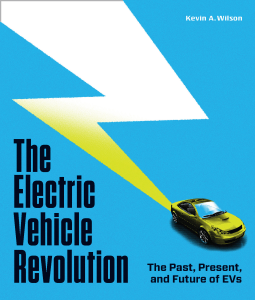
The Electric Vehicle Revolution
The Past, Present, and Future of EVs
by Kevin A. Wilson
This title was previously available on NetGalley and is now archived.
Send NetGalley books directly to your Kindle or Kindle app
1
To read on a Kindle or Kindle app, please add kindle@netgalley.com as an approved email address to receive files in your Amazon account. Click here for step-by-step instructions.
2
Also find your Kindle email address within your Amazon account, and enter it here.
Pub Date Nov 07 2023 | Archive Date Oct 12 2023
Quarto Publishing Group – Motorbooks | Motorbooks
Talking about this book? Use #TheElectricVehicleRevolution #NetGalley. More hashtag tips!
Description
In The Electric Vehicle Revolution, automotive journalist Kevin Wilson provides a thorough, engaging overview of where EV technology is today, how it got there, and where it’s going. Since the turn of the twenty-first century, EVs have gone from wonky who-cares vehicles like GM’s EV1 and early Teslas to every manufacturer's must-have future.
Electric propulsion preceded fossil-fuel cars by decades and even vied for prominence in the early twentieth century auto industry against both steam power and internal combustion engines. From Electrobat (an early New York taxi fleet) through Columbia—which had built 1,000 electric cars before either Henry Ford or Ransom Olds had built a single gasoline car—viable business start-ups in the early auto age were as competitive and innovative as those in early twenty-first century Silicon Valley.
But it was not to be for electric cars in the early days of the 1900s, as the auto industry evolved to favor gasoline cars, thanks in part to the influence of the oil industry and the build-out of infrastructure to supply fuel across the country.
Gas-powered cars may have won the day, but post-WWII experiments with electric cars continued both within the established auto industry and from outside firms and visionaries, including cars developed by General Electric, Sears, and the Henney Kilowatt, alongside Ford and GM experimentals.
Rapidly evolving electronic technology beginning in the 1960s, along with growing concerns about emissions and pollution, set the stage for renewed interest in electric cars. Improved batteries for cellphones/laptops, electronic controls, computing, and beyond provided the impetus for a wave of more sophisticated and feasible electric vehicles, including GM’s EV1 and the first Teslas.
Elon Musk’s Tesla Motors proves the auto industry disruptor and sets the stage for responses by the mainstream auto industry, including Nissan’s Leaf, Chevrolet’s Bolt, and a host of high-end EVs from company’s like Audi, Jaguar, and the like. Rival start-ups step in as well and government incentives, subsidies, and regulatory demands all drive unprecedented development.
Today, the rush to electrify has nations and companies competing to see who can declare the earliest end to internal combustion engines, but this radical transition won’t be as easy as throwing a switch. The Electric Vehicle Revolution thoroughly explores the challenges of infrastructure, battery and vehicle tech, and the cost to consumers, as well as the long phase-in as EVs are set to replace existing gas cars over decades.
Whether you embrace EVs or have gasoline in your veins, The Electric Vehicle Revolution provides a fascinating, engaging, and stunningly illustrated overview of where the car world is today and where it’s headed for the future.
Available Editions
| EDITION | Other Format |
| ISBN | 9780760378304 |
| PRICE | $35.00 (USD) |
| PAGES | 176 |
Available on NetGalley
Average rating from 2 members
Featured Reviews
I have always been deeply fascinated by electric vehicles (EVs) and the latest developments in this transformative technology. The historical account provided here sheds light on the remarkable journey of electric propulsion, which predates fossil-fuel cars by several decades.
It's intriguing to learn about the early competition and innovation in the auto industry during the early twentieth century. Electric cars, exemplified by pioneers like the Electrobat and Columbia, were once on the same playing field as steam and internal combustion engines. These early startups were as competitive and forward-thinking as the tech startups of today's Silicon Valley.
However, the narrative takes a turn as we delve into the reasons why electric cars did not dominate the automotive landscape in the early 1900s. The influence of the oil industry and the expansion of gasoline infrastructure played a pivotal role in favoring gas-powered vehicles. It's a poignant reminder of how external factors can shape the course of technological evolution.
The post-WWII period saw renewed interest and experimentation with electric cars, with both established auto industry players and visionary outsiders like General Electric, Sears, and the Henney Kilowatt entering the scene. Despite the dominance of gasoline cars, these experiments highlighted a persistent curiosity about electric propulsion.
The mention of evolving electronic technology from the 1960s onward is particularly captivating. The convergence of technological advancements in batteries, electronics, computing, and concerns about emissions marked a turning point. It set the stage for the resurgence of electric cars, leading to the development of more sophisticated and practical electric vehicles, such as GM's EV1 and the groundbreaking Tesla models.
This historical account not only underscores the cyclical nature of innovation but also highlights the importance of persistence and adaptation in the face of evolving circumstances. It's a testament to the resilience and potential of electric propulsion in shaping the future of transportation.
In conclusion, this narrative provides a thought-provoking journey through the history of electric vehicles, offering insights into their past challenges and the promising future they represent in our ongoing quest for sustainable and efficient transportation solutions.



